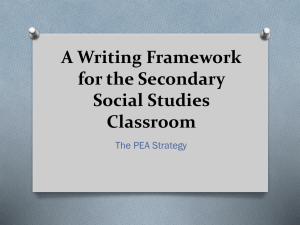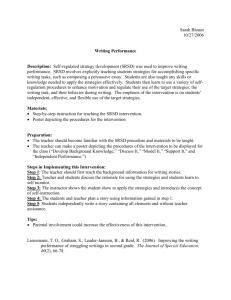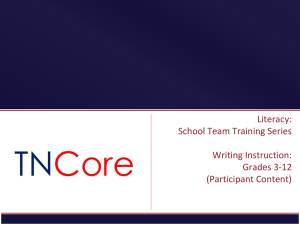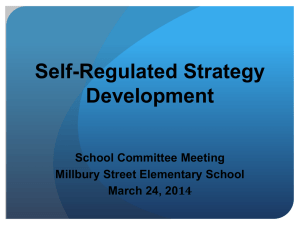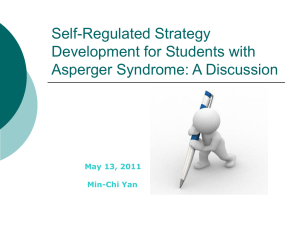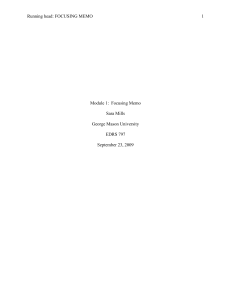Implementing Self-Regulation Strategies in Math to Promote Intrinsic
advertisement
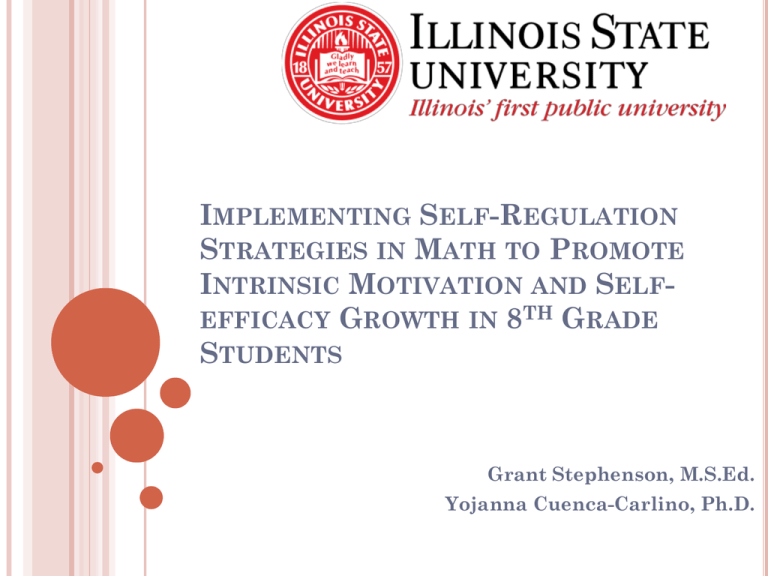
IMPLEMENTING SELF-REGULATION STRATEGIES IN MATH TO PROMOTE INTRINSIC MOTIVATION AND SELFEFFICACY GROWTH IN 8TH GRADE STUDENTS Grant Stephenson, M.S.Ed. Yojanna Cuenca-Carlino, Ph.D. TEACHER PARTICIPATING IN RESEARCH Grant Stephenson M.S.Ed. Secondary math and history undergraduate degree. Currently teaching 8th grade math Interest in special education led to pursuing my current master’s degree from Illinois State University. I am NOT an expert! I just wanted to share my research. I hope it is helpful. A VIDEO? Or 2.. AGENDA Research study used to guide implication Background Research questions Overview SRSD Stages Specific Lessons Data Measurements Results Teaching a Lesson Implications for Practice What I learned as an educator and why I feel it is important BACKGROUND/ LITERATURE REVIEW Math and CCSS • Only 34% and 27% of fourth and eighth grade students respectively are proficient in math. • Students with learning disabilities have difficulty assessing their ability to solve problems, identify and select appropriate strategies, organize information, monitor problem solving processes, evaluate problems for accuracy, and generalize strategies to appropriate situations (Miller & Mercer, 1997). SRSD • SRSD involves six basic stages of instruction that include (a) developing and activating background knowledge; (b) discussing the strategy including benefits and expectations; (c) cognitive modeling of the strategy; (d) memorization of the strategy; (e) collaborative support of the strategy; and (f) independent practice (Lienemann & Reid, 2006). BACKGROUND/ LITERATURE REVIEW Math and CCSS • One way to assist students with learning disabilities with the shift to more contentfocused classes is to provide them with effective and efficient learning strategies. SRSD • During instruction, students are taught to self-regulate their learning by setting goals, self-instructing, selfmonitoring, and selfreinforcing • To date, the majority of SRSD research has sought to improve the writing process of students with LD and emotional and behavioral disorders, but it has been used in mathematics on a select number of times. RESEARCH QUESTIONS To what extent does the SRSD model of instruction improve students at-risk for mathematical difficulties or identified with a LD, computational skills and accuracy on grade level multi-step equations? Would students be able to maintain gains after instruction is provided? To what extent was the intervention provided with fidelity by the classroom teacher after training was provided? Would student’s self-efficacy improve as a result of instruction? How do students perceive the effectiveness of SRSD instruction? RESEARCH OVERVIEW A multiple probe across participants design 6 middle school students both with and without learning disabilities. 5 females Three groups of students 1- N=2 2- N= 2 1 males 3- N= 2 Self-Regulated Strategy Development Instruction to Solve Multi-step Equations for Middle School Students with Learning Disabilities or Identified At-Risk Instruction was provided during the student’s tier 2 math intervention Part of school’s RtI program Classroom Teacher Research team: one professors, 2 undergrad students, one graduate student DATA MEASUREMENTS Equation Probe Assessed on percentage correct Baseline, post, maintenance Self-Efficacy Survey Given during baseline and post intervention. Student Interviews Only given during post intervention. “SELF-REGULATED STRATEGY DEVELOPMENT” SRSD : Stage 1 Develop background knowledge SRSD: Stage 2 Discuss the strategy • Increase background knowledge • Sign the contract • Discuss self-determination • Discuss solving equations • Discuss terminology associated with equations •Introduce DCMCR •“Don’t Catch My Cat Whiskers” •Introduced visual aid to show mnemonic with the equations SRSD-Stage 3 Modeling the strategy SRSD- Stage 4 Memorize the strategy SRSD- Stage 5 Guided practice SRSD- Stage 6 Independent Practice • Discuss self-statements and write self-statements • Observe the teacher modeling how to work through the mnemonic • Learn about the checklist to use for solving equations • Introduce self-monitoring sheet •Practice memorizing the strategy •Longest of the stages, student practice solving equations with the guide of the teacher •Students use self-statements and self-monitoring sheets throughout these stages Students require little or no support while solving equations Students remain on this stage until they successfully solve all equation consistently Checklist and other materials are not used essays SRSD-STAGE 1 “DEVELOP BACKGROUND KNOWLEDGE” Discuss relevant information and background BACKGROUND KNOWLEDGE FOR SOLVING EQUATIONS Purpose of solving an equation and how to check an equation Terminology Variables, constant, coefficient, etc. Distributive Property Combine Like Terms Inverse Operations STAGE 2 – “DISCUSS IT” Introduce and discuss the mnemonic created “Don’t Catch My Cat Whiskers” Don’t = Distribute Catch = Combine Like Terms But Remember! “Pick the vine and never trip and ultimately intelligent oranges impress old shoes. My = Multiply or Divide Cat = Check Whiskers = Way to go you are done! LET’S PUT IT TOGETHER THROUGH AN EXAMPLE (SRSD – 3 MODEL) 3(x + 2) + 2x = 3x + 14 DCMCW Distribute 3(x + 2) + 2x = 3x + 14 3x + 6 + 2x = 3x + 14 *During stage 1 of instruction, the distributive property was reviewed and practiced. This was not the first time students were introduced to this property. DCMCW “CATCH” OR COMBINE LIKE TERMS There are two parts to this step. Like terms on the SAME SIDE Like terms on OPPOSITE SIDES 3x + 6 + 2x = 3x + 14 5x + 6 = 3x + 14 2x = 8 DCMCW – “MULTIPLY/ DIVIDE” 2x = 8 X=4 DCMCR – ‘CHECK” x=4 Substitute the solutions in for the variables. 3(x + 2) + 2x = 3x + 14 3(4 + 2) + 2(4) = 3(4) + 14 3(6) + 8 = 12 + 14 18 + 8 = 12 + 14 26 = 26 (It checks out!!) DCMCW Way to go you are done!! STAGE 4 Memorize it Students spend a couple of days practicing memorizing the mnemonic itself We used flash cards to help with this stage STAGE 5 – GUIDED PRACTICE STAGE 6 – INDEPENDENT PRACTICE Students continue to self-monitor their work However, in this stage, students are working without the visual aid and checklist Students continue on this stage until mastery is complete RESULTS Overall, students math performance and self-efficacy increased significantly. Motivation increased slightly, but the gains were not as significant as in the equations and self-efficacy data. Also, maintenance data suggests that the strategy helped with the retention of equation solving. So, what did this mean for me? Although the data was not exactly aligned to my predetermined goals, I still felt as though many valuable lessons were learned. DI SRSD Baseline Postinstruction Maintenance 100% 90% 80% 70% 60% 50% Alice 40% 30% April Percentage of Steps Completed Correctly 20% 10% 0% 0 1 2 3 4 5 6 7 8 9 10 11 12 13 14 15 16 17 18 100% 90% 80% 70% May Lucy 60% 50% 40% 30% 20% 10% 0% 0% 100%200%300%400%500%600%700%800%900% 1000% 1100% 1200% 1300% 1400% 1500% 1600% 1700% 1800% 100% Nicole 90% 80% 70% 60% 50% Nick 40% 30% 20% 10% 0% 0 1 2 3 4 5 6 7 8 9 10 Sessions 11 12 13 14 15 16 17 18 IMPLICATIONS FOR PRACTICE SRSD stages Implications Stage 1 “Develop Background” Stage 2 “Discuss Strategy” Important to develop background in any subject. Students need to know and understand the background to anything they are learning. Understanding the background can help the students to better understand “Why” things happen in math. Developing a strategy to help students process their thinking can be very students to check their progress themselves, which results in increased self-efficacy. Developing a specific strategy can also promote self-regulation through a certain skill. Student-created mnemonic? IMPLICATIONS FOR PRACTICE SRSD stages Implications Stage 3 “Model it” Stage 4 “Memorize it” For any student, modeling is key! Students need to see what they are expected to do, how to think, and what questions to ask themselves. At first I thought using a script was difficulty, but later found that it really made me focus on the specifics of my modeling. If a strategy is created, it is useless unless the students remember it. Students need time. It is not helpful to students if you move on without them fully understanding what they are expected to do. IMPLICATIONS FOR PRACTICE SRSD stages Stage 5 ”Guided Practice” Implications Stage 6 “Independent Practice” To prevent incorrect application of a skill, guided practice is important. This is also a great opportunity to provide positive support, which will then increase student self-efficacy. Providing enough time to practice on their own is important for student growth. As teachers, we are not really able to view what has been learned until the students work completely on their own. Like with the checklist and selfmonitoring sheets used, providing students with opportunities to reflect and record results is important for self-regulation. Implications SRSD can be an effective solution for implementing self-regulation to students both with and with out learning disabilities. I think the process of breaking down a long processed problem into smaller pieces is what really helps makes this successful. Even if not fully implemented, different concepts of SRSD can be adapted to fit many different lessons and many different skills. Writing is most often associated with SRSD strategies. Writing involves a process and so does solving equations. I believe that SRSD could be applied to many different skills that require a process completion. APPLICATION IN MY OWN CLASSROOM Recently, I taught an equation unit to my four 8th grade math classes. Spent much more time “developing background knowledge” than I have ever done in the past. Didn’t use the exact mnemonic, but focused heavily on developing patterns in their work. Consistent guided practice, followed by independent practice. Provided many opportunities to “self-check” and “regulate their own progress” to work on those selfregulation skills as well. Implementing the SRSD components, although not exactly as intended, has also proved beneficial to my students this year. QUESTIONS? REFERENCES Brodesky, A., Parker, C., Murray, E., & Katzman, L. (2002). Accessibility strategies toolkit for mathematics. Retrieved May 18, 2004, fromhttp://www2.edc.org/accessmath/resources/strategiesToolkit.pdf Case, L. P., Harris K. R., Graham, S. (1992). Improving the mathematical problem-solving skills of students with learning disabilities: Self-regulated strategy development. The Journal of Special Education, 26, 1-19. Cassel, J., & Reid, R. (1996). Use of a self-regulated strategy intervention to improve word problem-solving skills of students with mild disabilities. Journal of Behavioral Education, 6(2), 153. Chung, K. H., & Tam, Y. H. (2005). Effects of cognitive-based instruction on mathematical problem solving by learners with mild intellectual disabilities. Journal of Intellectual and Developmental Disability, 30, 207-216. Cuenca-Carlino, Y., & Mustian, A. L. (2013). Self-regulated strategy development: Connecting persuasive writing to self-advocacy for students with emotional and behavioral disorders. Behavioral Disorders, 39(1), 3-15. Ennis, R. P., Jolivette, K., & Boden, L. J. (2013). STOP and DARE: Self-regulated strategy development for persuasive writing with elementary students with E/BD in a residential facility. Education & Treatment of Children (West Virginia University Press), 36(3), 81-99. Gast, D. L. (2010). Single subject research methodology in behavioral sciences / david l. gast New York : Routledge, 2010. Gersten, R., Chard, D., Jayanthi, M., Baker, S., Morphy, P., & Flojo, J. (2008). Mathematics instruction for students with learning disabilities or difficulty learning mathematics: A synthesis of the intervention research. Portsmouth, NH: RMC http://www.centeroninstruction.org/files/Teaching%20Math%20to%20SLD%20Meta-analysis.pdf Harris, K. R., Graham, S., &Mason, L. H. (2003). Self-regulated strategy development in the classroom: Part of a balanced approach to writing instruction for students with disabilities. Focus on Exceptional Children, 35(7), 1. Harris, K.R., Graham, S., Mason, L.H., & Friedlander, B. (2008). Powerful writing strategies for all students. Baltimore: Brookes. Hauth, C., Mastropieri, M., Scruggs, T., & Regan, K. (2013). Can students with emotional and/or behavioral disabilities improve on planning and writing in the content areas of civics and mathematics? Behavioral Disorders, 38(3), 154-170. Hoover, T. M., Kubina, R. M., & Mason, L. H. (2012). Effects of self-regulated strategy development for POW+TREE on high school students with learning disabilities. Exceptionality, 20(1), 20. Krawec, J., Huang, J., Montague, M., Kressler, B., & de Alba, A. M. (2013). The effects of cognitive strategy instruction on knowledge of math problem-solving processes of middle school students with learning disabilities. Learning Disability Quarterly, 36(2), 80-92. doi:10.1177/0731948712463368 Leinemann, T. O., & Reid., R. (2006). Self-regulated strategy development for students with learning disabilities. Teacher Education and Special Education, 29(1), 3-11. Miller, S. P., & Mercer, C. D. (1997). Educational aspects of mathematics disabilities. Journal of Learning Disabilities, 30, 47-56. Montague, M. (2007). Self-regulation and mathematics instruction. Learning Disabilities Research & Practice (Wiley-Blackwell), 22(1), 75-83. doi:10.1111/j.1540-5826.2007.00232.x National Council of Teachers of Mathematics. (2000). Principles and standards for school mathematics. Reston, VA: Author. National Center for EducationStatistics (2013).The Nation’s Report Card:A First Look: 2013 Mathematics and Reading(NCES 2014-451).Institute of Education Sciences, U.S. Department of Education, Washington, D.C. Scruggs, T. E., Mastropieri, M. A., Berkeley, S. L., and Marshak, L. (2010). Mnemonic strategies: Evidence-based practice and practice-based evidence. Intervention in School and Clinic, 46, 79-86. doi: 10.1177/1053451210374985. Steele, M. M., & Steele, J. W. (2003). Teaching algebra to students with learning disabilities. Mathematics Teacher, 96, 622-624. The Center on Instruction (2008)
